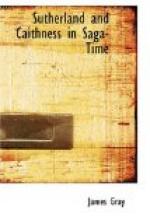In 1165 Sweyn Asleifarson, the great Viking, would be cruising on the northern and western coasts with Harold’s son, Hakon, on board, until their deaths in Dublin in 1171.
As for those in authority, Harold Maddadson would have as contemporaries, Freskyn of Duffus till his death between 1166 and 1171, and his son William till his death near the end of the 12th century, when Hugo, son of William, would succeed to the Morayshire estates, though probably he had previously obtained a grant of the land then known as Sudrland or Sutherland, which is defined above. Hugo probably received this grant after William the Lion’s first conquest of Sutherland and Caithness in 1196, shortly before the time when, as we shall see, Harald Ungi obtained in right of his mother a grant of half Orkney from the Norse king, and another from the king of Scotland of half Caithness, and probably a confirmation of his title to the Moddan lands in Strathnaver and in Halkirk and Latheron, to which he was heir in right of his father and grandmother Audhild of the Moddan line. But this half of Caithness would be conferred on Harald Ungi subject to the prior grant of Sudrland to Hugo Freskyn. For Harold Maddadson must, in the opinion of so eminent an authority as Lord Hailes, have been forfeited in 1196, if not earlier, for both he and his son Thorfinn were then in open rebellion against the Scottish Crown.[34]
Further deprivations of lands, it is conjectured, must have attended Harold Maddadson’s later rebellions, and the events which must have led to those deprivations may now be recounted, though it is very difficult to reconcile Scottish and Norse records during the period.
In 1179 King William the Lion had marched an army into Ross, and subdued it to his sway; and, ere he left it, caused two castles of Eddirdovir on the site of Redcastle in the Black Isle on the Beauly Firth, and of Dunskaith[35] on the northern Suter of Cromarty, which is full of Norse remains, to be built, to enable him to hold his conquests.
Two years later he made war on Donald Ban MacWilliam, who claimed the Scottish Crown itself, as the third son of William FitzDuncan only son of Duncan II, who was himself the eldest son of Malcolm Canmore by Malcolm’s first marriage, so productive of civil war in Scotland, with Ingibjorg, widow of Earl Thorfinn. Civil war ensued, and lasted for six or seven years, when, by good luck, Roland of Galloway fell in with a force of the rebels at an unknown spot called Mamgarvie near Inverness, and routed them, killing Donald Ban MacWilliam there on the 31st July 1187.[36]




